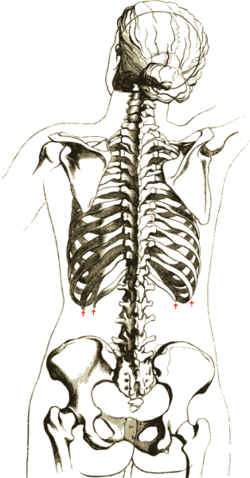True ribs
| True ribs | |
|---|---|
| Anterior surface of sternum and costa cartilages. (True ribs are first seven.) |
The first seven ribs are connected behind with the vertebral column, and in front, through the intervention of the costal cartilages, with the sternum; they are called true ribs or vertebro-sternal ribs.
False ribs
| Bone: False ribs | |
|---|---|
| Anterior surface of sternum and costa cartilages. (False ribs are last five ribs.) |
The false ribs are the five sets of ribs below the top seven true ribs. Of these:
- the first three (eighth, ninth, and tenth rib) have their cartilages attached to the cartilage of the rib above (vertebro-chondral):
- the last two (eleventh rib and twelfth rib) are free at their anterior extremities and are termed floating ribs or vertebral ribs.
Ninth rib
The frontal part of the ninth rib is at the same level as the first lumbar vertebra. This level is called planum transpyloricum, since the pylorus also is at this level.Floating rib
| Floating rib | |
|---|---|
| (The four floating ribs (indicated with red arrows) | |
| (The six lower ribs on a woman (left) and a man. Note how small the four floating ribs are, especially on a woman.) |
Floating ribs are four atypical ribs (two lowermost pairs, XI-XII) in the human ribcage. They are called so because they are attached to the vertebrae only, and not to the sternum or cartilage coming off of the sternum. Some people are missing one of the two pairs. Others have a third pair. Most, however, possess only two pairs.
Their position can be permanently altered by a form of body modification called tightlacing, which uses a corset to compress and move the ribs.
Additional images
Intercostal space
| Intercostal space | |
|---|---|
| Intercostal spaces, viewed from the left. | |
| Sternocostal and interchondral articulations. Anterior view. |
The intercostal space (ICS) is the space between two ribs (Lat. costa). Since there are 12 ribs on each side, there are 11 intercostal spaces.
Importance of intercostal space
Because the chest is protected by the rib cage, the intercostal spaces are important access points in medicine, for example:
- access for surgical procedures, e.g. resection of (part of) the lung (pneumonectomy), or insertion of a chest tube
- penetrating trauma of the thorax
- for percussion and auscultation of underlying structures, e.g. sites for heart auscultation, percussion in Traube's space, etc.
Structures in intercostal space
- several kinds of intercostal muscle
- intercostal arteries and associated veins
Order of components
Comprehensive insight in the anatomy of the intercostal spaces is mandatory for everyone who practices medicine. One particular concept is that the neurovascular bundle has a strict order: V-A-N, or vein-artery-nerve, from top to bottom (as illustrated). This neurovascular bundle runs high in the intercostal space: therefore, the intercostal space should be penetrated as low as possible by invasive procedures.
In reference to the muscles of the thoracic wall, the intercostal nerves and vessels run just behind the internal intercostal muscles: therefore, they are generally covered on the inside by the parietal pleura, except when they are covered by the innermost intercostal muscles, subcostal muscles or the transversus thoracis muscle.

















No comments:
Post a Comment